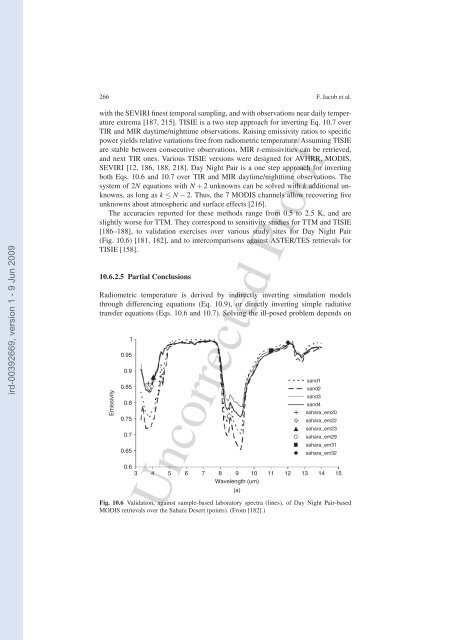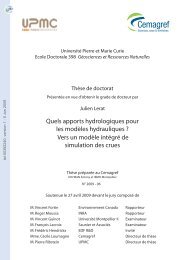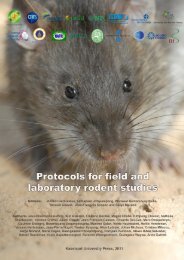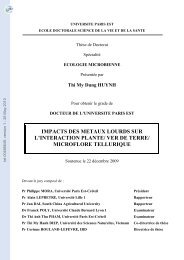266 F. Jacob et al.ird-00392669, version 1 - 9 Jun 2009with the SEVIRI f<strong>in</strong>est temporal sampl<strong>in</strong>g, <strong>and</strong> with observations near daily temperatureextrema [187, 215]. TISIE is a two step approach for <strong>in</strong>vert<strong>in</strong>g Eq. 10.7 <strong>over</strong>TIR <strong>and</strong> MIR daytime/nighttime observations. Rais<strong>in</strong>g emissivity ratios to specificpower yields relative variations free from radiometric temperature. Assum<strong>in</strong>g TISIEare stable between consecutive observations, MIR r-emissivities can be retrieved,<strong>and</strong> next TIR ones. Various TISIE versions were designed for AVHRR, MODIS,SEVIRI [12, 186, 188, 218]. Day Night Pair is a one step approach for <strong>in</strong>vert<strong>in</strong>gboth Eqs. 10.6 <strong>and</strong> 10.7 <strong>over</strong> TIR <strong>and</strong> MIR daytime/nighttime observations. Thesystem of 2N equations with N + 2 unknowns can be solved with k additional unknowns,as long as k ≤ N − 2. Thus, the 7 MODIS channels allow rec<strong>over</strong><strong>in</strong>g fiveunknowns about atmospheric <strong>and</strong> surface effects [216].The accuracies reported for these methods range from 0.5 to 2.5 K, <strong>and</strong> areslightly worse for TTM. They correspond to sensitivity studies for TTM <strong>and</strong> TISIE[186–188], to validation exercises <strong>over</strong> various study sites for Day Night Pair(Fig. 10.6) [181, 182], <strong>and</strong> to <strong>in</strong>tercomparisons aga<strong>in</strong>st ASTER/TES retrievals forTISIE [158].10.6.2.5 Partial ConclusionsRadiometric temperature is derived by <strong>in</strong>directly <strong>in</strong>vert<strong>in</strong>g simulation modelsthrough differenc<strong>in</strong>g equations (Eq. 10.9), or directly <strong>in</strong>vert<strong>in</strong>g simple radiativetransfer equations (Eqs. 10.6 <strong>and</strong> 10.7). Solv<strong>in</strong>g the ill-posed problem depends onEmissivity10.950.90.850.80.750.70.65s<strong>and</strong>1s<strong>and</strong>2s<strong>and</strong>3s<strong>and</strong>4sahara_em20sahara_em22sahara_em23sahara_em29sahara_em31sahara_em320.63 4 5 6 7 8 9 10 11 12 13 14 15Wavelength (um)(a)Uncorrected ProofFig. 10.6 Validation, aga<strong>in</strong>st sample-based laboratory spectra (l<strong>in</strong>es), of Day Night Pair-basedMODIS retrievals <strong>over</strong> the Sahara Desert (po<strong>in</strong>ts). (From [182].)
10 <strong>Model<strong>in</strong>g</strong> <strong>and</strong> <strong>Inversion</strong> <strong>in</strong> <strong>Thermal</strong> <strong>Infrared</strong> <strong>Remote</strong> Sens<strong>in</strong>g 267ird-00392669, version 1 - 9 Jun 2009the available remote sens<strong>in</strong>g <strong>in</strong>formation. A priori <strong>in</strong>formation is needed to obta<strong>in</strong>good results with <strong>in</strong>stantaneous s<strong>in</strong>gle channel or dual channel / dual angle data. Itcan be avoided with more remote sens<strong>in</strong>g <strong>in</strong>formation: <strong>in</strong>stantaneous TIR <strong>and</strong> MIRdata, <strong>in</strong>stantaneous multispectral TIR data, or temporal series with dual channeldata. Similarly, more surface <strong>and</strong> atmospheric parameters can be rec<strong>over</strong>ed with alarger amount of remotely sensed <strong>in</strong>formation.Reported accuracies have <strong>in</strong>creased these last years, <strong>and</strong> are now closer to thatrequired for further applications, i.e., 1 K. For <strong>in</strong>stance, differences between retrievalsfrom ASTER/TES <strong>and</strong> MODIS/TISIE were found lower than 0.9 K, thoughboth methods differ <strong>in</strong> terms of us<strong>in</strong>g spectral, directional <strong>and</strong> temporal <strong>in</strong>formation[158]. However, ASTER/TES, MODIS/Split W<strong>in</strong>dow <strong>and</strong> MODIS/Day NightPair were found very different <strong>over</strong> Northern America [206]. Current efforts are ref<strong>in</strong>ementsrather than new concepts: desegregation methods should allow benefit<strong>in</strong>gthe synergy between IASI hyperspectral <strong>and</strong> AVHRR kilometric sensors onboardMETOP. Then, the next challenge is retriev<strong>in</strong>g more elaborated temperatures, discussedbelow.10.6.3 Aerodynamic TemperatureAerodynamic temperature T aero <strong>and</strong> thermal roughness length z oh are equivocal variableswhich cannot be directly rec<strong>over</strong>ed from remote sens<strong>in</strong>g (Section 10.4.1).Therefore, <strong>in</strong>vestigations have aimed at substitut<strong>in</strong>g aerodynamic for radiometrictemperature T rad , by parameteriz<strong>in</strong>g a correct<strong>in</strong>g factor <strong>in</strong> the sensible heat flux expression(Eq. 10.1).The physical mean<strong>in</strong>g of sensible heat flux (Eq. 10.1) can be preserved us<strong>in</strong>g themultiplicative factor T aero − T air (z re f ), empirically expressed from LAI [162]. However,study<strong>in</strong>g this factor from simulations <strong>and</strong> measurements for grow<strong>in</strong>g sparseT rad − T air (z re f )vegetation showed significant variations accord<strong>in</strong>g to meteorological <strong>and</strong> surfaceconditions [63].The correct<strong>in</strong>g factor can also be <strong>in</strong>cluded <strong>in</strong> the kB −1 parameter (Eq. 10.2),which is then called thermal kB −1 [113]. It <strong>in</strong>cludes corrections for (1) the differencebetween thermal <strong>and</strong> mechanical roughness lengths, <strong>and</strong> (2) the differencebetween radiometric <strong>and</strong> aerodynamic temperatures. Accord<strong>in</strong>g to environmentalconditions, thermal kB −1 varies from a vegetation type to another, <strong>and</strong> up to 100%<strong>in</strong> relative terms [113, 219]. Parameterizations based on near surface w<strong>in</strong>d speed<strong>and</strong> temperature gradients depend on sensible heat flux [220]. Overall, formulat<strong>in</strong>gthe thermal kB −1 seems almost impossible, s<strong>in</strong>ce it is driven by several factorswhich vary <strong>in</strong> time <strong>and</strong> space: vegetation structure <strong>and</strong> water stress, meteorologicalconditions, canopy temperature profile <strong>and</strong> solar position [221–229].A potential way for characteriz<strong>in</strong>g the kB −1 parameter would be multiangularTIR remote sens<strong>in</strong>g [230]. However, us<strong>in</strong>g this <strong>in</strong>formation for deriv<strong>in</strong>g soil<strong>and</strong> vegetation temperatures seems more pert<strong>in</strong>ent. First, these temperatures areUncorrected Proof
















